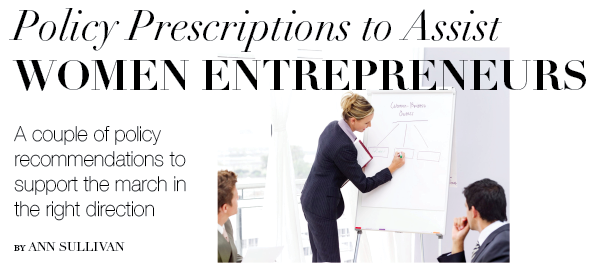
Does the name Alice Paul ring a bell? Alice Paul led the effort to give women the right to vote. She raised money for the cause, led a group of White House protesters known as the Silent Sentinels, was imprisoned three times, force-fed raw eggs when she staged a hunger strike, and kept the pressure on President Wilson to support ratification of the 19th Amendment. She was all of these things, but above all else, she was a fierce advocate on behalf of women.
Today, hunger strikes or stage protests to stop traffic are less common, but we do raise money and we do advocate for the advancement of women-owned businesses. Having just celebrated Women’s History Month, the following are policy changes that will enhance the growth of women owned businesses.
Strengthen Counseling for Women Business Owners.
There are 106 Women Business Centers (WBCs) across the country that counsel and train more than 137,000 entrepreneurs and aspiring entrepreneurs annually, creating 700 new businesses a year at a cost of $122 per person. Last year, WBCs outperformed their goals by 18% and enjoy high customer satisfaction ratings. With the success of these women business centers, Congress should invest in more funding to establish additional centers and to boost the ones currently in existence. The centers are required to match these federal grants by raising matching funds from other sources, but with $14 million in federal money for the whole program they are boot strapped. Women deserve better.
In addition, other entrepreneurial training and counseling programs operated by the U.S. Small Business Administration (SBA) should be given priority when it comes to funding. Programs such as the Program for Investment in Microentrepreneurs (PRIME) are critical pieces of the puzzle when it comes to supporting women entrepreneurs with the skills needed to successfully run a business. Studies show that these investments pay off. According to the Association for Enterprise Opportunity’s (AEO) most recent report, Bigger than you Think: The Power or
Microbusiness in the United States, businesses that receive training have higher success rates (88% are still in business after five years, compared to a 50% success rate for businesses that do not) and have average annual revenues 38% higher.
Similarly, the Department of Labor (DOL) should encourage entrepreneurship as a viable job strategy. The DOL oversees a national network of job training centers, which are allowed to provide entrepreneurial training to unemployed individuals interested in starting a business – thus creating a job for themselves. However, a barrier exists that prohibits these centers from counting people starting a business as a “successful employment outcome,” and discourages these centers from providing entrepreneurial training. The DOL should change their performance metrics to accept a business startup as a successful employment outcome.
Increase Capital Access for Women-owned Businesses.
Women entrepreneurs continue to struggle to access capital to start or grow a business. According to Women Impacting Public Policy’s (WIPP) most recent annual member survey, women make an average of two attempts to access capital, securing a loan only 60% of the time.
The SBA operates a number of loan programs essential to women-owned small businesses: the 7(a) loan program, the Microloan Program, and the 504 commercial real estate loan program. These programs are supported by federal funding, meaning any decrease in funding reduces their ability to make loans. Congress should ensure adequate funding in order to meet the demands of women-owned businesses.
The advent of online crowdfunding is another recent development and step in the right direction, allowing businesses to raise up to $1 million. However, the Securities and Exchange Commission (SEC) threatens to derail it from taking off with burdensome compliance and reporting requirements. The SEC should ensure these costs stay at a minimum to allow this innovative model to take off.
Bring Women to the International Marketplace.
March 8th was International Women’s Day — a good reminder that expanding U.S. women’s business presence abroad through exporting should be a top priority. Many women business owners limit themselves to selling domestically because the international market is too daunting. A simpler, streamlined exporting process, one focused on getting our products abroad, would help. The dividends are significant: women-owned businesses that exported have on average more than 100 times the total annual receipts, five times as many employees, and more than triple the receipts per employee than those only selling domestically. WIPP operates an export education platform, ExportNOW focused on encouraging more women entrepreneurs to engage within the global marketplace to increase their success.
Bring Parity to the Women’s Federal Contracting Program.
The U.S. federal government is the world’s largest consumer —spending more than half a trillion dollars annually. You may be surprised to know that the goal — not mandate — for federal agencies to buy from women-owned companies is 5%;and the government has never met it. The Women-Owned Small Business (WOSB) procurement program, designed to ensure the mandate is met, does not have parity with other contracting programs. There are some bills to combat this in Congress — though none have been a priority for the leadership. That seems to be what the suffragettes fought for — parity. So why are we fighting for this 100 years later?
The histories of women like Alice Paul, and the countless other Suffragettes, serve as reminders of how hard we have fought to achieve the present. But more work needs to be done. To quote Alice Paul, “When you put your hand to the plow, you can’t put it down until you get to the end of the row.” We won’t.
—

Ann Sullivan
WIPP Government Relations
1156 15th Street, NW, Suite 1100
Washington, DC 20005
202-626-8528

 Login
Login
